England Day 1: Oxford University
Today, I crossed
off one of the top five cities on my list of places to see before I die. Oxford
and Oxford University are now done for the first time, but I know I will want
to be going back many times in the future. Not only is the school an incredible
part of history—both architecturally and academically—but the city of Oxford
itself has such a great variety of iconic museums and cute little places to
shop. I had so much fun seeing everything it has to offer, even if it did rain
on us a little bit toward the end of the day!
We set off
around 9AM to make the hour drive up to Oxford. The trip did not seem long,
probably because I was so excited to finally be seeing a place I had dreamt
about for so long. We arrived safely at the car park just outside the city,
purchased tickets for the short bus ride into town, and then got off right in
the center of everything. Immediately, I could tell that the day was going to
be a great one.
So many historic
buildings! So many cool shops and restaurants! A covered market! Colleges! Old
statues! Anything and everything I imagined showed up in some way or another,
all within just the first little walk around. We ended up walking through
Christ Church college to get to Merton college, where our host went to school. Though
the porter was reluctant to let more than one visitor in with the alumna, he
eventually said that we could walk through the main courtyard to get to Merton
the short way. This way, though we did not actually get to see the inside of
the biggest college at Oxford, we at least got to peek into the front area and
marvel at the huge square space in the middle of everything.
Slowly exiting
to the other side of the campus, we peeked in on a much smaller college’s green
on the way through: Corpus Christi college. Even though it isn’t as large, it
was still just as magnificent as all the other buildings. After a bit more walking,
we arrived at the cobblestone street where Merton college lives. Oxford is the
city of bikes, and Susan said that riding hers on the bumpy stones to get home
was not always a fun time. But it still makes the whole place look that much
more special and historic.
We got past the
porter with no trouble and then went out into the main courtyard. Merton’s
courtyard is very special because it is one of the only ones at Oxford that
does not have grass—instead, theirs is made of different types of stone fitted
into triangular patterns. It was very cool, actually. Though the pristine grass
looks nice with the old buildings as a backdrop, this was an interesting twist
to the traditional way of doing things.
From the main
courtyard, we could see the entrance to the cafeteria, the front of the chapel,
and some of the dormitory buildings that lead through to other greens and
smaller courtyards. We made a quick visit to the food hall first, which had an
amazing door and an even more amazing interior. Literally, this place was
Hogwarts. Being American, I have no real exposure to boarding school halls,
portraits of former wardens staring at me, or fancy wooden tables and benches.
Seeing this formal area to eat in for the every day was stunning. I think that
many Americans think that Hogwarts was somehow special in its depictions of the
cafeteria—at least, that is what I thought this whole time. But no, apparently
this is how nice eating spaces really are at prestigious English (and Scottish)
schools. Crazy.
After that
intense introduction to Oxford life, we went through to the chapel. Luckily for
us, the one resident organ scholar was practicing with quiet intensity. I know
how hard organs are to play, so I know just how good he was. And the instrument
sprung up from the ground with intention of being noticed—this thing was
magnificent. Merton college takes extreme pride in its wonderful instrument, as
it definitely should. Seeing and hearing it was a real treat.
But the chapel
itself was also a beautiful space. We learned that the original plan was to
extend the nave out where the organ was, past the transepts that exist today.
But because they failed to do that, the chapel is much smaller, and the chancel
has become the entire nave and altar space combined. Nonetheless, the space is
still in great shape. The wood work on the benches and the ceiling paintings
are all very impressive and well-preserved. There are also many stone grave
markers lining the floor, all extremely old as well. This place was like a
living preservation of history, right before my eyes.
Once leaving the
poor student to practice his music in peace, we walked out through to another
smaller courtyard, this one with the traditional lawn. It had a particularly
impressive archway leading on into the next courtyard, which I thought was the
best one. And I was not wrong in that—apparently when the Prince of Japan went
to Merton in the 80s with our hosts Susan and Michael, his room was one of the
ones to look out on this beautiful space. There is a wonderful wrought iron
gate that has a great view of the start of the Merton gardens and more bright
green grass. The windows all have little alcoves sticking out, often part of a
wall covered in ivy or flowering plant vines. A funny detail that Susan pointed
out, however, was that there was only one set of real windows on the top
floor—the rest are painted in to look like the others!
From there, we walked to see the Merton green. Not many other colleges have this much field space that is just grass, so it is quite a special feature for Merton. But the surrounding garden is in competition with all the rest of the colleges’ gardens, in addition to the beautiful grassy area. The flowers are incredible—literally rows of irises with name cards waiting to bloom, rose vines trailing up the walls, specifically drawn out segments of bed for certain flowers to live in. It was the most intense version of gardening I have ever seen. But it would certainly explain why the gardeners’ digs are so nice. They definitely earn their keep.
We walked past a
few more buildings to try to get into the T.S. Eliot theater, but it was sadly
locked. It is apparently the most modern part of Merton college, in an effort
to make businesses more comfortable paying more to rent the space. Susan also
made a note of how odd it was to have it be locked, as when she went there,
everyone’s name was labeled by their flat number and doors to academic common
rooms and even dorms were never locked. After trying and failing at the door,
we walked back out through the front quad and said goodbye to Merton for the
day.
We took Merton
Street back up to High Street, where we walked along and looked at a few more
places. This included an antique shop, where I looked to find a set of
Pimpernel coasters featuring the fox hunt print. It was incredible—the moment I
walked in and looked around a bit, there were a set of six just sitting in a
box on the ground. I did not expect to find anything that quickly, so this took
me by complete surprise. I did not end up purchasing them, but I did appreciate
having found them so quickly!
Other stops on
High Street included Queen’s College, which is not to be mistaken for or
mislabeled as Queens’ College. It is the Queen’s College, named after Queen
Philippa of Hainault, who was married to King Edward III of England. Though the
college was not open to visitors, we got to look in to the main quad and see
the beautiful tower and archway. Like everything else we’d seen so far, it was
very impressive.
Our next stop
was the rotunda, the famous Radcliffe Camera library. Though it was originally
an independent library built to house science collections, the library is now
home to English, history, and theology books and Bodleian Library reading
rooms. This would make it my home on Oxford’s campus. The building is situated
in the middle of Radcliffe Square, which has underground rooms that can hold up
to 600,000 books!
Across the street is University Church, called St. Mary’s.
This functions as a public Oxford parish but consists mainly of Oxford college
buildings, making it the official university chapel. Many people like to climb
the tower and see the Camera from up high. Sadly, only card holders could get
in, but I took enough pictures of the outside to satisfy my curiosity.
Hopefully I’ll be back someday in the future to see the inside.
A little bit of
conscious wandering then ensued. We had about an hour until the set lunch time,
and Susan wanted to make it to Exeter college to see about a tour for future
students’ parents. So we went back through Catte Street to see the beautiful
Bridge of Sighs, then cut through to get to Broad Street, where a lot of the
tourist shops are. Blackwell’s Bookshop, a historic four-level shop, lives
there, too. We would see that later in the day. We saw the Sheldonian Theater,
where all university ceremonies (including graduation) are held, and the crazy
architecture of the Museum of the History of science.
Since we were walking right past it, we also took a detour up Magdalen Street to see the Martyr’s Memorial—a tall spire standing at an intersection to commemorate the executions of three Anglican Bishops teaching at Oxford. They were tried and hanged for heresy for spreading their religious teachings, and the spire still stands today as a reminder of their sacrifice for the sake of learning.
We then took a
quick spin through Balliol College, which is just another amazing example of
medieval architecture. The chapel there was also beautiful, and the outside was
almost striped thanks to the unique choice of stones used to build it. After
walking up through Turl Street to get to Exeter, we found that it was closed
for the day for a number of different events. We were able to look around the
main quad, but not go inside anywhere. Disappointing, yes. The chapel
especially looked very cool from the outside, which means the inside could only
get better. But by that point, we were very hungry and ready to get some Thai
food.
The place we ate
was apparently a local recommendation called Chiang Mai Kitchen, since we were
meeting one of Susan’s college friends who is now married to a lecturer. She
said she goes there all the time, and that it used to be a French restaurant
when they were in school. The building is magnificent—crooked wooden spiral
stairs and old windows straight out of a movie, and each empty space was
decorated with a Thai statue or painting. This mixing of culture added an odd
medieval flair to our modern global meal. The meal itself was absolutely
delicious—we each ordered one plate and shared with whomever wanted any. We
also got this delicious jasmine tea that was just wonderful. I didn’t know that
I liked jasmine tea until I tried it, adding that drink to the ever-growing
list of foods I did not know I liked until I tried them on this trip. We had
vegetarian green curry, seafood red curry, pad Thai, and two chicken dishes to
share. It was phenomenal and I would recommend it to anyone as a quirky local
place that not many tourists will venture into.
After lunch, we
made a quick stop at Ben’s Cookies, a place I had heard about but never thought
I would have a chance to try. We thought the cookies were so good that we
decided to make plans to go back again once more before we left the city for
the day. The first time around, I got a double chocolate cookie with a
delicious hunk of melty chocolate in the middle. The second time, I opted for a
nice regular dark chocolate chip, with the same delicious bit of melted
goodness in the middle. Definitely a unique way of making cookies, but
absolutely a way that I have to try. After sampling two out of the eight
cookies they have to offer, I would highly recommend stopping by a Ben’s
Cookies!
With our cookies
in tow, we headed down Parks Road to get to the outer rim of campus, where the
museums live. We had walked past one famous one—the Ashmolean Museum—when we
went to see the Martyr’s Memorial. Our main choice to visit, however, was the
Museum of Natural History and the Pitt Rivers Anthropological Collection. As an
anthropology student, the Pitt Rivers collection really seemed like something I
would enjoy looking through. Once we arrived, however, we found it difficult to
locate. We walked around what we thought was the Pitt Rivers for about an hour
and a half, only to discover that we had just been looking at the Museum of
Natural History collections rather than the actual Pitt Rivers collection. Oh
well. It always helps to ask, as we found out the hard way.
Even so, I am
glad that we got to spend some time with the other exhibits. The main hall of
the Natural History Museum is absolutely stunning—huge skylights supported by
metal framework and filled to the brim with skeletons, preserved specimens, and
taxidermied animals from around the world. The main floor houses a lot of
marine animals and mammals, whereas the second floor has bugs and insects
(alive and dead, for added excitement). We walked through the evolution of
marine shellfish, then went upstairs to see some amazing Victorian era samples
of butterflies and watch a live praying mantis in his museum home.
We made a quick
skirt through the minerals and gemstones, then walked on to see the current
exhibit of the museum by Kurt Jackson: Bees (and the odd wasp) in my Bonnet. It
was a fascinating mixture of art and ecological awareness, since bees have been
on the watch list for some time now. It showed bees in a beautiful form, in a
way that cannot harm those who are somewhat afraid of them. Kurt Jackson is an
extremely talented artist, who mixes modern style with an elegance lacking in
some recent artworks. My favorite pieces were the ones with metal dipped bees
resting in a three-dimensional setting and then framed in a shadow box. Not
only is the metal pretty to look at, but it can be seen as a metaphor for how precious
bees are to our world and the things we would typically deem “beautiful”:
flowers, butterflies, etc. Without bees, none of those things would exist. The
world would be a sad place without the help of these little workers. This was a
great exhibition and I was pleased we stumbled upon it.
After another
quick spin around the ground floor to see some mammal skeletons and photograph
a fox, we finally asked where the actual Pitt Rivers collection was. They told
us, and we headed straight for it. The museum would be closing soon, and we
wanted to make sure we had as much time to see everything as we could, since we
had been told it was packed to the brim with weird, fascinating items from
human history. And boy, was that the truth.
We walked into
the ground floor entrance to the collection and were immediately overwhelmed
with just how much stuff was packed in to the room. Various glass cases labeled
with things like “lanterns”, “treatment of dead”, “writing utensils”, and
“wicker baskets of North America” took up almost every part of the floor space.
The only room allowed in between was room for one person, and one person only,
to walk through and look at them. The outer walls were also covered in
floor-to-ceiling cases, full of clothing and artifacts from around the world.
There was a whole case full of Japanese Noh masks, another case with Tibetan Buddhist
masks from India, and tons of examples of Native American clothing and
beadwork. The collection even had a whole section on saddler, with examples
from all different eras of history and areas of the world. It was stunning, to
say the least.
The second floor
was organized by material type, with wood and metal being the two main
exhibits. As I was admiring the display of spears in one of the cases, Diana
told me to look up at the rest of them. Confused, I looked up toward what I
thought would be the ceiling, and we surprised to find a whole backup
collection of spears resting parallel to the floor above our heads. Pitt
Rivers, in his time as an archeologist and ethnologist, must have been serious
about collection as many things as possible. I see no other reason for one man
to have that many examples of cultural artifacts. It made me think about the
countless people who had to give up these items, or wonder where they ended up.
Do they really belong in an English museum? Probably not. But it was
fascinating nonetheless, especially to someone like me.
We walked through the rest of the second floor to see huge collections of dolls, jewelry, and sacred items, then walked up to the third and final floor. It was time to see every weapon imaginable, along with the armor used to accompany it. First was a wide selection of guns, muskets, and rifles from every place guns existed. Many of them were ornately detailed using ivory inlays, etching, or metal detailing. I was very impressed with the level of craftsmanship achieved by these gun smiths, even way back then.
Axes and swords
were next, with the same unique and eclectic mix of time periods and geographic
areas as the rest of the collection. Many of the blades were also beautifully
enhanced with etchings or patterns, which, again, struck me as incredible. Even
more spears lined the next few sets of cases, and the exhibit ended with
projectile forms of defense: bow and arrows, boomerangs, and swinging clubs.
All in all, it was very well organized for being such an extreme conglomeration
of seemingly unrelated objects. As over stimulating as it was, I am so happy I
got to see one of the largest and most comprehensive anthropological
collections in the world—and all for free!
Somewhat tired,
we walked out into the rainy weather to complete our trip with a spot of
shopping. We had seen various stores we wanted to return to, so we set out to
find them. Our first stop was a stationary and bibliophile store called Scriptum.
Adamant on doing things the analog way, Scriptum was a stunning array of
handmade leatherbound journals, feather quills, monogrammed wax seals, letter
correspondence kits, printing press paper, and quirky accessories. I was
basically in heaven, and had to restrict myself to only purchasing an Italian
paper notepad and a couple beautiful multi-layer postcards. Leaving without
everything was a true struggle. It is a good thing they have a website!
Our final stop
of the day was Blackwell’s Bookshop, founded in 1879 in its original Broad
Street shop. Though they are officially an academic book retailer, they do have
a number of mainstream books on the top level. Downstairs, however, is the
vault that holds countless shelves of books on four sunken levels. It was an
amazing encounter with a famous historic business. I was so happy to get the
chance to walk through and see the magic that books can bring.
After that, we
quickly hurried back so that we could get a seat on the bus back to the car
park. There was quite the line, and it was still raining, but we eventually
made it on and made the ride back to the car. The drive back was hard, because
we realized how exhausted we were. We were happy to make it back to Salisbury
after a long day of exploring. But no matter how tired I was or how much my
feet were sore and wet, I would not trade seeing that city for anything. It was
absolutely an amazing trip—one that also guaranteed that I would be coming back
some day. Until next time, Oxford.
♥














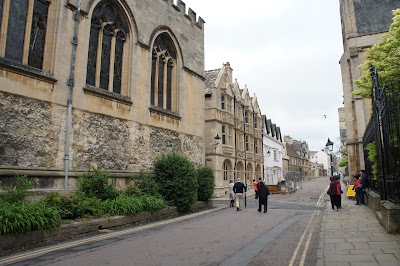


















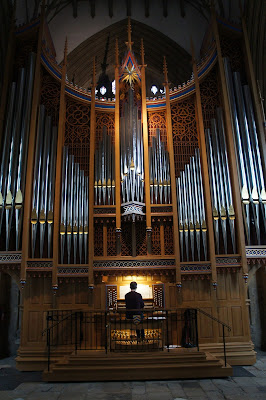






























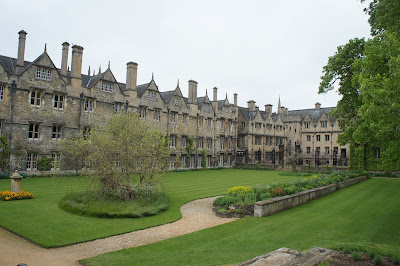












































































































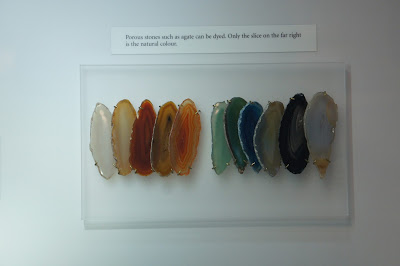




































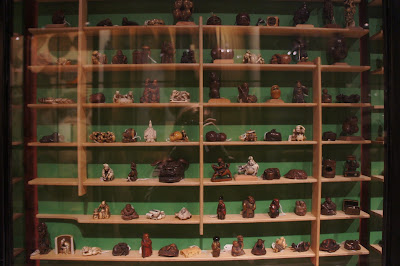


































No comments:
Post a Comment